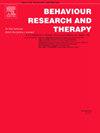The combination of physical exercise and slow-paced breathing on psychophysiological indices of emotion reactivity, psychosocial stress reactivity and recovery: A multimodal investigation
IF 4.5
2区 心理学
Q1 PSYCHOLOGY, CLINICAL
引用次数: 0
Abstract
Stress is a major public health problem calling for scalable interventions. Physical activity (PA) and slow-paced breathing (SPB) can reduce stress, both by modulating cardiac parasympathetic activity. Given their shared target but different mechanisms, combining SPB and PA could enhance their stress-reducing effects. This study therefore explores whether SPB (vs control breathing at a faster rate) after PA increases the impact of PA on psychophysiological indices of emotional reactivity and psychosocial stress reactivity and recovery. In a crossover randomized design, 77 healthy volunteers completed twice a baseline, a bout of PA (at a personalized intensity), 3 × 5 min of breathing (SPB at 5,5 or control breathing at 15 breaths per minute), an emotional reactivity task with negative versus neutral images, a psychosocial stress task and a recovery phase. We measured psychophysiological indices of stress (i.e., heart rate, vmHRV, skin conductance, blood pressure, pupil dilation as well as self-reported stress and mood indices, rumination and coping strategy). Compared to control breathing, SPB decreased worry and made the difference between cardiac reactivities to negative and neutral images lower (as measured through interbeat intervals [IBI]). No effects on other psychophysiological indices of stress were found. Our results are the first to emphasize the potential of combining PA and SPB to reduce worrying and attenuated cardiovascular reactivity to emotional valence. However, the lack of effects on other stress indices indicates the need for future research to explore its broader applicability as a stress management technique.
体育锻炼与慢节奏呼吸相结合对情绪反应、社会心理应激反应和恢复等心理生理指标的影响:一项多模式调查。
压力是一个重大的公共卫生问题,需要采取可扩展的干预措施。体育活动(PA)和慢节奏呼吸(SPB)可以通过调节心脏副交感神经活动来减轻压力。鉴于它们的作用靶点相同但作用机制不同,SPB和PA联合使用可以增强它们的减压效果。因此,本研究探讨了PA后的SPB(与以更快的速度控制呼吸相比)是否会增加PA对情绪反应性和社会心理应激反应性和恢复的心理生理指标的影响。在交叉随机设计中,77名健康志愿者完成了两次基线,一次PA(以个性化强度),3 × 5分钟呼吸(SPB为5,5或控制呼吸,每分钟15次呼吸),负面和中性图像的情绪反应任务,心理社会压力任务和恢复阶段。我们测量了压力的心理生理指标(即心率、vmHRV、皮肤电导、血压、瞳孔扩张以及自我报告的压力和情绪指数、反刍和应对策略)。与控制呼吸相比,SPB减少了焦虑,并使心脏对阴性和中性图像的反应性差异更小(通过心跳间隔[IBI]测量)。应激对其他心理生理指标无影响。我们的研究结果首次强调了PA和SPB结合的潜力,以减少担忧和减弱心血管对情绪效价的反应。然而,对其他应力指标的影响不足,表明需要进一步研究以探索其作为应力管理技术的更广泛适用性。
本文章由计算机程序翻译,如有差异,请以英文原文为准。
求助全文
约1分钟内获得全文
求助全文
来源期刊

Behaviour Research and Therapy
PSYCHOLOGY, CLINICAL-
CiteScore
7.50
自引率
7.30%
发文量
148
期刊介绍:
The major focus of Behaviour Research and Therapy is an experimental psychopathology approach to understanding emotional and behavioral disorders and their prevention and treatment, using cognitive, behavioral, and psychophysiological (including neural) methods and models. This includes laboratory-based experimental studies with healthy, at risk and subclinical individuals that inform clinical application as well as studies with clinically severe samples. The following types of submissions are encouraged: theoretical reviews of mechanisms that contribute to psychopathology and that offer new treatment targets; tests of novel, mechanistically focused psychological interventions, especially ones that include theory-driven or experimentally-derived predictors, moderators and mediators; and innovations in dissemination and implementation of evidence-based practices into clinical practice in psychology and associated fields, especially those that target underlying mechanisms or focus on novel approaches to treatment delivery. In addition to traditional psychological disorders, the scope of the journal includes behavioural medicine (e.g., chronic pain). The journal will not consider manuscripts dealing primarily with measurement, psychometric analyses, and personality assessment.
 求助内容:
求助内容: 应助结果提醒方式:
应助结果提醒方式:


